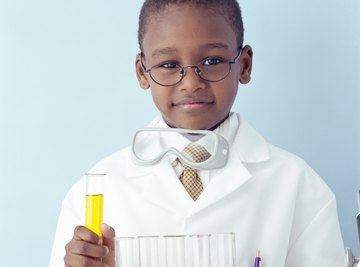
Fourth graders, like most younger students, find chemical change experiments especially intriguing. Watching substances change and learning the science behind the change is a high-interest activity for the science classroom. Physical change occurs when substances change but retain their identity. However, with chemical change, the substances change and become something else.
Dissolving in Vinegar
To do this experiment, you need the egg shell from a hard-boiled egg, a calcium tablet from an oyster shell, vinegar, water, white chalk, a tablespoon made of metal, two straws and two small cups. Draw a chart on a paper and make three rows across for the eggshell, chalk and calcium tablet, and two rows down, one for water and one for vinegar. Take a sample of the chalk, tablet and eggshell and crush it with the back of the metal tablespoon in the spot on the chart where it's indicated. Place a few drops of water of each sample in the water row, using the straw. Observe any changes. Next, do the same in the vinegar row with a few drops of vinegar and observe changes. Explain that vinegar is actually acetic acid, and when combined with calcium carbonate, they come apart and form new chemicals.
Chemical Bubbles
Show students how a chemical change can yield bubbles. Label one plastic cup baking soda and the other vinegar. Pour three tablespoons of vinegar and three tablespoons of water in the cup labeled vinegar. Pour the solution into a clean, plastic soda bottle and add a one-quarter teaspoon of dishwashing detergent. Swirl carefully but do not shake. Tape a funnel made out of paper. Place three tablespoons of baking soda into the appropriately labeled cup, then use the paper funnel to pour the baking soda all at once into the soda bottle. Swirl the mixture and observe what happens. Explain that in the chemical change, you created carbon dioxide gas, water and sodium acetate.
Slime
For an extra-appealing experiment on chemical change for your fourth-grade class, make some slime. To do this experiment, you'll mix white glue, but not the washable kind, and an equal amount of water. In another container, combine two tablespoons of Borax with a cup of water. Borax is found in the laundry section of stores. Add a few tablespoons of the Borax solution to the glue solution and quickly mix them together. Watch as the chemical change results in some delightfully gooey slime.
Goop
Fourth graders will enjoy the messy chemical change that results from this Glop experiment. It's simple and takes items easily available: cornstarch and water. Simply mix together equal amounts of those two items and watch the chemical change. Try to get children to determine what type of substance it is — a solid or liquid. It is actually in a state between and therefore, is hard to handle or describe but quite fun to play with.
References
About the Author
Katlyn Joy has been a freelance writer since 1982. She graduated from Southern Illinois University-Edwardsville with a master's degree in writing. While in school she served as graduate assistant editor of "Drumvoices Revue" magazine.
Photo Credits
Digital Vision/Digital Vision/Getty Images
